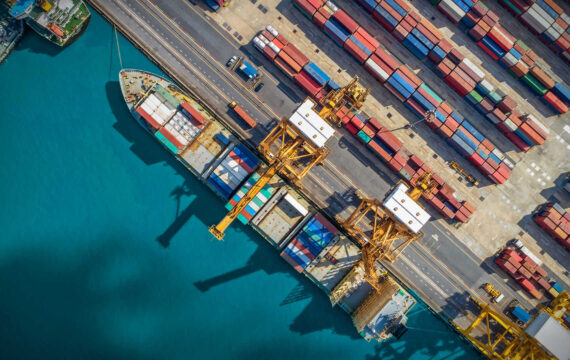Sustainability has become a nagging concern, demanded by consumers, investors, and governments in unison. But what does sustainability in supply chain management actually mean? And how feasible is it to move from aspirations and goal-setting to making a tangible impact, especially in the wake of other disruptive events such as the ongoing pandemic?
We decided to look into these questions and take a detailed look at achieving sustainability in the supply chain using emerging technologies and novel approaches to process management.
What is supply chain sustainability?
Supply chain sustainability is a set of corporate activities aimed at ensuring fair labor practices and environmental protection at every link in the supply chain, from the bottom up. By combining processes, policies, and technology, supply chain leaders are looking to optimize every facet of the product journey, from sourcing raw materials to delivering products to consumers.
Key areas of sustainability in supply chain include:
- Fair worker compensation and decent working conditions
- Eco-friendly and ethical raw material sourcing
- Minimization of the carbon footprint during transportation
- Waste reduction and optimized natural resource use
- Collection of full product traceability and provenance data
- Having a positive impact on communities where the company operates
A company’s entire supply chain can make a significant impact in promoting human rights, fair labor practices, environmental progress, and anti-corruption policie.
To achieve sustainability in supply chain management, business leaders are focused on infusing a greater degree of transparency in supply chain operations. Procured data can then be used to locate weak links and problematic practices for improvement.
Given the increasing rate of supply chain digitization, technology and supply chain sustainability are inextricably linked; the first enables the second, as we’ll discuss in this post.
What’s driving the demand for sustainable supply chain practices?
From ecological catastrophes to vocal activists and recent healthcare events, global supply chains have been under major strains over the past several years. Other bold reasons for sustaining supply chains are listed in a given MIT report:
Source: MIT Center for Transportation and Logistics — State of Supply Chain Sustainability 2020
The drivers of greater sustainability in supply chains can be classified into three general groups:
- Emerging consumer demands
- The rise of impact investing
- Global eco agendas
Let’s dig into these.
Consumer demands for sustainability
Modern consumers are mindful of where their products come from and how they are produced.
Search volumes for terms such as “sustainability,” “zero waste,” and “eco-friendly” have boomed over the past twelve months. In the wake of the global pandemic, many consumers were forced to change their shopping habits. It seems that many also took this time to reflect on how their daily decisions affect others around the world. From supporting local heritage brands to boycotting multinational brands that fail to ensure employee safety, modern shoppers are embracing social causes and seeking out brands that align with their values.
Here are the latest consumer statistics on sustainability in supply chains:
- According to a 2020 report by the IBM Institute for Business Value in collaboration with the National Retail Federation, 6 in 10 shoppers are willing to change their habits to reduce environmental impact. Also, among those who rank sustainability as very important, over 70% would pay an average 35% premium for sustainable and environmentally responsible products.
- Deloitte reports that 9 in 10 millennials prefer buying from companies that seek sustainable supply chains, fair employee compensation, animal welfare, and reduced food waste.
- DHL states that 50% of their customers now ask for corporate social responsibility (CSR) information as part of their tender process.
- The Global Web Index (GWI) indicates that for 85% of shoppers, a company’s poor environmental track record is a good reason to stop purchasing the company’s goods. On the other hand, most industries have solid potential to monetize their CSR practices:
Industries with most potential to monetize CSR

Source: The Global Web Index — CSR trends that can make or break a brand
Pressure from investors to go green
Individual and corporate investors are also encouraging corporations to double down on social and environmental sustainability.
Asset managers, representing trillions of dollars of investments, have petitioned the world’s largest greenhouse gas-emitting companies to reduce emissions by 45% by 2030 and create plans for reaching zero-carbon objectives by 2050 or earlier.
Impact investing is on the rise too. Over 90% of investors in alternatives (including pension funds, endowments, and insurers) believe that adhering to UN Sustainable Development Goals (SDGs) will help address global sustainability issues.
By the end of 2021, 40% of investors in alternatives plan to integrate SDGs into their investment activities.
Global legislative agendas for reaching green goals
Nearly every country has set targets for becoming fully carbon neutral in the next thirty years.
- The EU and the UK aim to be climate neutral by 2050.
- China has pledged to become carbon neutral by 2060.
- The US has pledged to reach carbon neutrality by 2050.
These pledges press companies to seek sustainability in logistics, reducing pollution and resource waste from manufacturing and addressing problematic agricultural practices.
On top of addressing greenhouse gas emissions, many governments are also pressuring businesses to address other problematic practices pertaining to supply chains and sustainability such as single-use plastic, excessive packaging, child labor, poor working conditions, and unfair compensation.
The global pandemic has further prompted regulators to address waste collection, waste minimization, and waste disposal in response to the growing amount of personal protective equipment (PPE) and face masks entering landfills.
Supply chain sustainability: key issues and technology solutions
The pressure to operate in a socially fair and environmentally friendly manner is intense.
But the road to sustainable supply chain operations and ultimate carbon neutrality is tough even for dedicated businesses.
Here’s why:
- Sustainable infrastructure is fragmented and there are few zero-emission manufacturers.
- Limited visibility into supply chains, especially for the lowest-level partners, prevents the recording of problematic practices.
- Bringing supply chains closer to consumers requires significant capital investment.
- Achieving sustainability in logistics requires better e-vehicle infrastructure and governmental support.
- Extra support needs to be provided by governments and regulators for creating sustainable infrastructure.
That’s the big picture of the issues corporations are facing.
On a smaller scale, however, many leaders have already managed to address (and even solve!) some of the troublesome issues affecting their operations thanks to a mix of process optimization and emerging technologies.
In this post, we highlight three supply chain management practices that can be made greener with the right technology.
Sustainable packaging
The growing volume of ecommerce transactions has not only pressured retailers to invest in digital supply chain management solutions for omnichannel operations but also to deal with the growing volume of cardboard packaging.
Demand for corrugated box shipments in the US rose by 9% between March 2019 and March 2020. Meanwhile, demand for filled-air packaging products (which are harder to recycle) is poised to increase by 8%, or $1.16 billion, between 2020 and 2024.
Globally, less than 14 percent of plastic packaging that is produced every year is recycled. If the current trend continues, there will be more plastic than fish in the oceans by 2050.
Companies and regulators have been addressing the packaging issue with varying degrees of success.
Walmart was an early committer to reusable packaging. But an investigation and follow-up lawsuit from Greenpeace suggests the retailer has been using “false and misleading” labels for its disposable plastic products and packaging.
Procter & Gamble set a goal to make 100% of its packaging fully recyclable by 2030. But the commitment has yet to be fully set in motion. Other consumer brands such as L’Oréal, Evian, the Coca-Cola Company, and Unilever) are also looking into the “box problem.”
Here are some sustainable packaging strategies being tested right now:
- Product refilling stations and multi-use containers for staples
- Switching to recyclable, reusable, biodegradable, and compostable packaging materials
- Introducing closed-loop logistics models where durable, multi-trip packaging assets are used
Still, switching to economically viable reusable packaging remains challenging, as adjustments are needed at different stages of the supply chain. Retailers and logistics providers need to consider:
- How reusable packaging will be tracked and rerouted back to businesses
- The speed and effectiveness of such reverse logistics processes
- Which facilities can offer cost-effective cleaning, maintenance, and inspection services for packaging assets
- How new types of packaging will be processed on conveyor belts, scanners, etc.
All of the above are pressing concerns. Thus, we’ve decided to look into potential technology solutions.
Tech solutions to reduce waste and packaging costs
Asset tracking and mapping technologies are a critical pillar for enabling a circular supply chain.
Granted, we already have sufficient technology for that:
Here’s how these technologies can be used to trace and reuse boxes and other reusable assets.
Depending on the asset type, you can either choose to equip an asset with an RFID tag, Bluetooth Low Energy (BLE) beacon, or printed QR code. Every party interacting with the asset can then scan it to receive the necessary logistics information. All this information can be automatically aggregated in a cloud-based asset tracking system, where you can monitor an asset’s journey through all checkpoints. With data science and predictive analytics, you can use this data to generate comprehensive, predictive reports and get insights for optimizing inefficiencies.
A consumer who receives goods in a box can also use a smartphone to obtain information on recycling or returning the box. For example, you can prompt a consumer to schedule a free pick-up with their next order or guide them to the closest asset collection point. Or you can strike a partnership with a local regulator to facilitate recycling. That’s what Recycling Dual did. The German company set up a full-cycle recycling process for local customers and ensures that packaging from their products is recycled through a nationwide collection system.
Product spoilage, damage, and returns
In the food and fast moving consumer goods (FMCG) industries, some brands hesitate to alter their packaging practices, fearing that it will affect product quality.
Their reservations are valid. Secondary packaging helps protect products from damage during all legs of transportation and prevents spoilage by serving as a barrier against environmental impacts such as light, humidity, and oxygen. Since most packaging currently used has already proved to be moderately effective at preventing spoilage, retailers and logistics companies aren’t rushing to change things.
However, as we mentioned earlier, single-use, non-recyclable packaging is growing into a waste problem. And one that businesses themselves are being forced to solve.
- Food recalls are pervasive, with microbiological contamination topping the list of reasons. A recent study pegged the average cost of a recall for a food brand at $10 million in direct and indirect costs.
- Product returns due to damage double freight costs. The average cost for a five-pound zone 4 residential ecommerce shipment is $11.66. If the product arrives damaged, the expense and profitability loss is $23.32, accounting for the reverse logistics cost and the cost for dispatching the replacement.
- No-reason product returns accounted for $428 billion in merchandise last year. By 2022, online retailers need to gear up for 13 billion units’ worth of returns, or $573 billion. Yet nearly half of all companies say returns are a pain point for their supply chain.
- 78 countries have regulations that govern e-waste disposal. In most cases, manufacturers are held accountable for dealing with this waste.
Tech solutions for improving reverse logistics and sustainability
To reduce perishability and recalls, retailers need to improve their cold chain logistics capabilities.
Using a combination of smart sensors, data loggers, location-based services, and integrated transportation management software solutions, supply chain managers can gain real-time insights into transportation conditions, plus exert remote control over shipments such as by adjusting the temperature or dispatching real-time instructions to a logistics partner.
Secondly, businesses need to introduce better reverse logistics solutions that will allow them to effectively re-route returns or damaged products to the right sites. They might even allow for more granular circular economy management as the chart below illustrates:
Combine forward and reverse logistics
Source: Archives of Business Research — The Role of Sustainability in Reverse Logistics for Returns and Recycling
Furthermore, applying big data analytics for inventory management can help offset the cost and complexity of managing returns.
Some companies are attempting to predict the flow of returns using data points such as:
- Average return volume per product category or customer demographic
- Most common reasons for returns
- Condition of returned goods
- Percentage of sales that are returned
Using the above insights, businesses can plan ahead for returns and work out strategies for reducing the number of returns in the first place.
Additionally, companies can use a mix of sensor technologies and analytics solutions to reduce the costs of processing returns.
The cost of inspecting that good, repackaging it, getting it back on the shelf, the reverse logistics — all of that often outweighs the value of the good from being sold the second time.
For example, you can introduce an automatic data capture system. Instead of asking your team to open packages, you can use scannable barcodes or RFID tags that will codify data about package provenance and the reason for the return. In fact, 44% of companies recently surveyed by USPS already use this feature.
By infusing the above system with machine learning and computer vision algorithms, you can also streamline the decision-making process. Using obtained data, a software system can advise you what to do with a returned product — send it back to the warehouse/fulfillment center, dispatch it for reconditioning, or upcycle it.
Logistics
Offsetting carbon footprints is a top-of-mind sustainability logistics concern.
Ineffective fleet management, lack of visibility into freight routes, and missing controls over logistics processes and practices drive up logistics costs and emissions.
Transportation activities (aviation, rail, shipping, heavy and light trucking) are responsible for approximately 17% of global greenhouse gas emissions.
Given the length and complexity of modern global supply chains, hardly any multinational business can fully avoid heavy-duty transportation. But introducing sustainable tech-led practices to certain operational aspects — be it last-mile delivery or on-site fleet management — can drive sizable ecological improvements and cost savings.
Technology-driven sustainable logistics solutions
One of the lowest-hanging fruits for achieving emission targets in logistics is delivery route optimization.
The latest generation of fleet management software enables transport managers to build dynamic routes for minimizing travel distance, travel times, and subsequently emissions. By monitoring a vehicle’s position in real time, you can build better routes to avoid congested areas, effectively handle multiple stops, and reduce the docking time at various checkpoints. Recently, Google Maps announced a feature that lets drivers create a route with the lowest carbon footprint. Greenplan estimates that such route optimization software can help reduce user’s carbon footprints, plus generate a 20% operational cost reduction.
Optimizing package size can reduce transportation costs. Most ecommerce products are overpackaged. A full 72% of consumers think retailers use too much packaging for online orders. And bigger boxes occupy more space in delivery vehicles, increasing fuel consumption and emissions.
To address the issue, American electronics retailer Best Buy recently invested in new equipment for minimizing packaging for online orders. The system builds custom-sized, optimized boxes by using sensors to measure a product’s size on the conveyor and then churning out the optimal box. Each box is fastened with glue instead of tape. The machine also leaves a perforated edge at one end so the box is easy to open. The system is said to reduce carton waste by 40% plus free up floor space in warehouses. Also, the retailer can now load more boxes into delivery trucks.
Finally, electric vehicles (EVs) are also poised to drive significant improvements in logistics sustainability. At present, 30% of all transport-related CO2 emissions come from fuel combustion. Switching to EV fleets at least for some legs of the logistics journey can dramatically reduce the carbon footprint.
DHL is already putting this idea to the test. The company plans to add over 11,000 electric delivery vehicles in the coming years and become a zero-emissions logistics company by 2050.
To conclude
Supply chain sustainability has become a priority for manufacturers, transportation leaders, and retailers alike. But until recently, most players have been focused on their personal agendas. A greater level of supply chain digitization and interoperability between supply chain participants can turn these disjointed efforts into targeted climate action across sectors. Collaboration will be key for driving measurable improvements and unlocking revenue gains that come from CSR!
Contact Intellias to learn more about improving supply chain visibility and addressing specific bottlenecks with new technology!




